Of Kings and Scribes
| May 9, 2023For Rabbi Alan Plancey, the crown on his kehillah, one of the fastest-growing Orthodox communities in the UK, tops any royal welcome
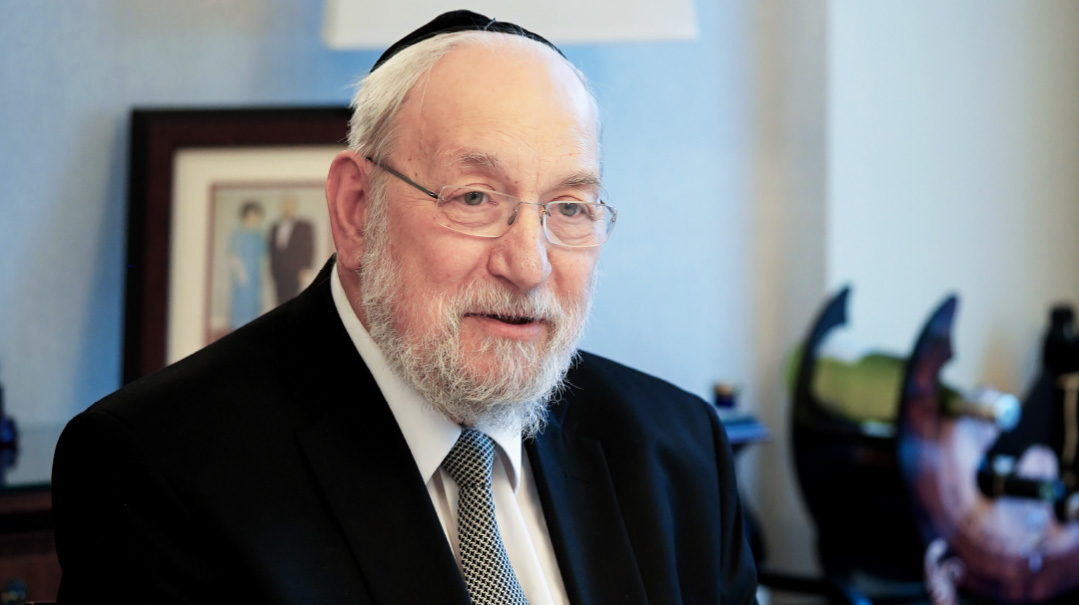
Photos: Mendel Photography
A country that celebrates its monarchy with compelling pomp and ceremony made sure King Charles III’s coronation last week was not only elaborate, but in tune with the times. “The king was surrounded by doting subjects,” says Rabbi Alan Plancey, retired pulpit rabbi, long-time chairman of the United Synagogue’s Rabbinical Council, and past mayor of Hertsmere, a borough just outside the London municipality, who was an invited guest at the king’s first garden party, a new start on the annual parties Queen Elizabeth presided over so graciously for decades.
The ornate gardens were awash with bright sunshine, and the celebrity guests were offered a “seasonal and organic” menu by climate-conscious Charles, instead of the traditional cucumber sandwiches, tea scones, and custard tarts. Rabbi Plancey knows the king from Charles’s previous interactions with the Jewish community, but in the massive crowd, he could not even get close enough to make the brachah over royalty. And with the royal family dealing with internal turmoil, every blessing for success and security would surely help.
As chairman of the United Synagogue’s Rabbinical Council, Rabbi Alan Plancey represented the UK’s Chief Rabbi at official functions through the tenures of Chief Rabbis Lord Immanuel Jacobovits and Lord Jonathan Sacks. He’s met every member of Britain’s royal family — plus the pope, the Dalai Lama, and Bill Clinton, and did so much interfaith work over the years that Lady Amelie Jacobovits a”h once called up to reprove him: “Alan, recently you’ve been going to church more than you’re going to shul!”
Closer to home, he was the rabbi of the shul in the London suburb of Borehamwood almost since that community’s inception, presiding over its growth from less than a hundred families to 1,200 families when he retired, and now one of the fastest-growing Orthodox communities in the UK. After retiring from this busy post in 2007, he served a smaller community for two years, then moved into local politics, becoming a councillor for the Conservative party and winning election as mayor of Hertsmere for a two-year term. He now has the title of honorary alderman.
We catch up with Rabbi Plancey in the family’s compact but comfortable and welcoming home on a quiet street in Borehamwood, where they have lived for 40 years. A kollel that Dayan Chanoch Ehrentreu a”h opened locally in 2019 means that there are new yeshivish families on the block, but Rabbi Plancey was definitely the first black hat in this pastoral suburban community. Still, his roots are very far from the leading cadre of rabbinic leadership and public service. He was born to Russian immigrant parents in Scotland, and intended to become a mathematician. How did he make the 180-degree turn to spend his life learning and teaching Torah instead?
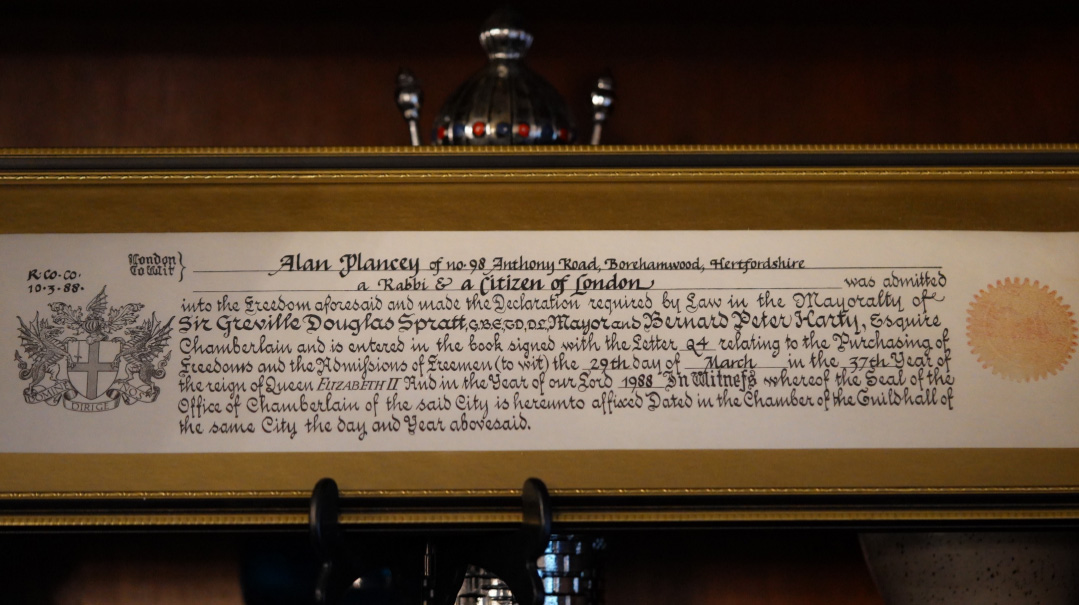
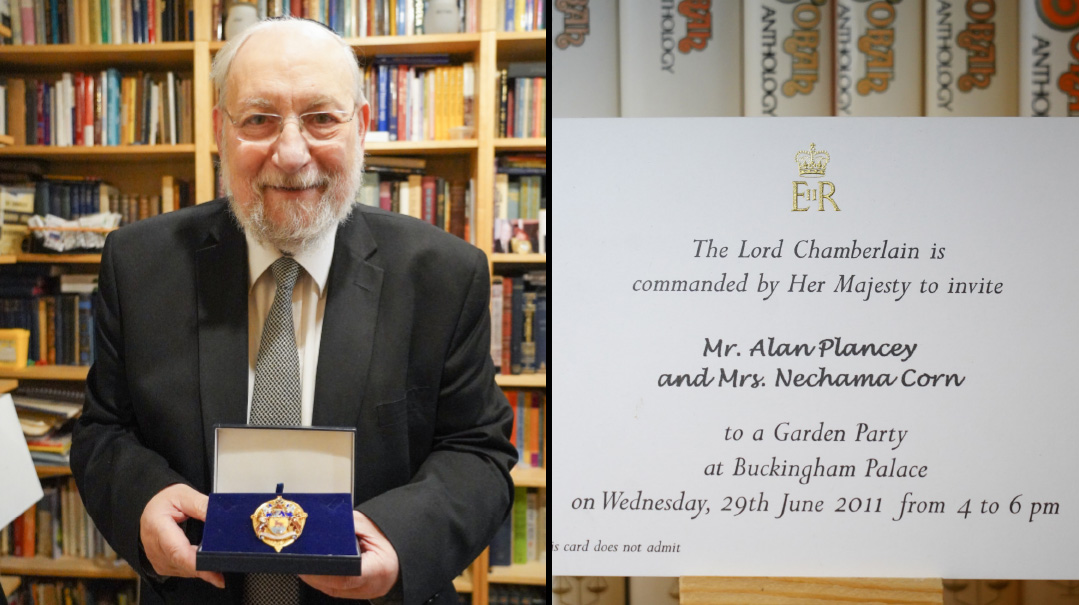
The bochur from Glasgow to the Chief Rabbi’s office. Rabbi Plancey’s encounters are a who’s who of personalities in the UK’s political and ruling class
Sometimes You Fight
It’s an accent you can’t misplace: Alan Plancey was born in Edinburgh, the Scottish capital, during World War II, while German bombs were still falling on Scottish targets. His parents soon moved to Glasgow, an industrial city Jewish immigrants had been flocking to since the 1790s, its first shul having opened in 1858.
“My grandparents had arrived in the UK from Poland and Russia with the name Polansky, which became Plancey,” Rabbi Plancey explains. “My father was a baker, and believe it or not, we lived in the Gorbals area [one of the city’s most infamous slums, today redeveloped into a prestigious district]. I know it was rough there over the years, but at the time it was a mechayeh, a nice Jewish area.”
A little later, the Planceys moved on from working-class Gorbals. And in a stroke of Providence, the rabbi of the shul in the new neighborhood, Rabbi Moshe Dryan — a talmid of the Chofetz Chaim and the nephew of Gateshead’s revered shochet Reb Dovid Dryan — invited the Jewish baker’s son to learn with him every Shabbos afternoon. That made an indelible impression, especially the stories he told about the Chofetz Chaim, which Rabbi Plancey still remembers.
In the local school he attended, the Jewish boys made up 80 percent of the roll, but most of them were not knowledgeable or strongly committed to Yiddishkeit. Some of them were absent on Yom Tov, but Alan Plancey was the only one who came late after davening in shul on Tishah B’Av and Purim.
The headmaster heard about it and called him in. “Are you the only Orthodox boy in the school?” he challenged. Alan Plancey was both direct and proud. “I said ‘Yes.’ That same headmaster had made a no-head-covering rule, but I wore my yarmulke the whole time. I wasn’t going to take it off,” Rabbi Plancey remembers. “I went to my rav, who contacted the Scottish Board of Education. They let the school know that I had the right to wear it.” It seems that Rabbi Plancey had learned from his feisty countrymen that sometimes it is necessary to fight.
Alongside his public-school education, Alan Plancey attended after-school cheder. He was drawn to Yiddishkeit, and was happy that the rabbis based in the city then, Rabbi Dryan, Rabbi A.L. Rubinstein in Giffnock Shul, and Rabbi Naftoli Shapiro, made time to learn with the boys. In addition to learning with Rabbi Dryan, Alan would walk the 45 minutes to Giffnock, another Jewish neighborhood, in order to learn with Rabbi Rubinstein. Not only would the time and warmth these rabbanim showered on him have a huge impact on the young man’s trajectory, they also taught him the role and the power of a rabbi. These rabbanim knew they were there not just to give the sermons in shul and the hespedim at funerals, but to teach and lead the community, especially the youth.
Alan Plancey completed the Scottish school system in the summer of 1958, when he was 16. With his A-level exams expected to receive high grades, he already had a place in university to study his strongest subject, mathematics. But that summer, the Ponevezher Rav paid a visit to Glasgow, Scotland, to fundraise for his yeshivah. There, in the Giffnock shul, Rabbi Rubinstein introduced his young talmid to the visitor.
For Rabbi Plancey, it’s an encounter he’ll never forget. “Rav Kahaneman got hold of me. I spoke no Yiddish, but he asked me very clearly what I was going to do. I said that I was going to university to study Maths. He took me, kissed me on both cheeks, and then he said, “Nein, nein. Gei arein in yeshivah und zei a talmid chochom.”
Alan Plancey listened. And when he explained to his parents that he wouldn’t be going to university but to yeshivah, his father gave the go-ahead, on condition that his son would still study for a profession.
Alan had hardly even opened a Gemara, though, when he applied to Gateshead yeshivah. “I learned privately with Rabbi Shapiro. I knew that the Rav had earned an MA in a field related to Geography, and when I asked him how he’d done that without speaking much English, he replied that all the knowledge was in the Gemara. I hadn’t seen anything inside the Gemara myself, though, when I applied to Gateshead. But Rabbi Rubinstein and Rabbi Dryan sent references for me, and I was accepted.”

Most of the shelves of Rabbi Plancey’s seforim room are filled with holy tomes, but a few awards peek out – including this “Freedom of the City” civic honor
O
ver the next five and a half years, the bochur from Glasgow would make himself deeply at home in Gateshead, advancing through the shiurim, immersing himself in learning, and living as any other yeshivah bochur. Once he had cracked that Gemara open and caught up to his contemporaries, he was a fish in water. He might have been at outsider at first, but he soon became a popular member of the chevreh. The learning experience was all-encompassing, especially since part of the time, Alan stayed in the home of the elderly menahel, Rav Eliezer Kahan. “It was such a kavod. I got up very early, and the menahel would make me a cup of coffee. He treated me like a father, and made me feel at home.”
Once he’d received semichah from Rosh Yeshiva Rav Leib Gurwitz and Gateshead’s Rav Bentzion Rakow, the newly minted rabbi knew he was headed directly for rabbanus: There were to be no kollel years. His parents back in Glasgow were fine with the yeshivah bochur their son had become, even buying from a different kosher butcher during his visits home, but his father had stipulated he would need a profession. In deference to this, he also learned how to shecht chickens and check them while he was in Gateshead.
June of 1965, the rabbi says, was a “very mazeldig time.” First, he met his wife, Miriam, née Hirsch, from Stamford Hill, a shidduch suggested by her brother a”h who learned in Gateshead Yeshivah. Second, he was accepted for his first rabbinical position, in the United Synagogue of a town called Luton, an hour’s drive north of London. He saw it as a chance to be a rabbi like those who had touched his own life, and Miriam was prepared to go along and serve the community at his side.
When the newly married Planceys arrived, Friday night davening in Luton’s shul was scheduled for eight o’clock all year round. Rabbi Plancey had to make a gamble to get the shul’s timing into sync with halachah. The owner of Luton’s football (soccer) team was a member of the shul. He had made his son’s bris and pidyon haben in the directors’ box at the football ground, and his friends at shul were avid supporters of the team, which competed in the national league. The members pressed their new rabbi to attend a match.
“I said I’d come along if it wasn’t on Shabbos, but I made a condition,” Rabbi Plancey says. “For every goal Luton scored at that match, the balabatim would come to an early Friday night davening. At that time, Luton was losing heavily, but when I went to the match, they won, five-nil. The Ribbono Shel Olam had set it up for me: We were going into winter, so everybody came to daven for five weeks, as it got earlier and earlier on Friday afternoon. Came the fifth week, and I asked them, ‘So, was that it?’ They said, ‘Rabbi, we enjoyed it so much, we’ll keep on coming early.’ ” They kept their word.
After a short time in Luton, the Planceys moved on to the upper-class London area of Hampstead Garden Suburb, where Rabbi Alan served as a youth rabbi under the inimitable scholar and orator Rabbi Isaac Bernstein, who was the shul’s rav. He’d had experience with young people in the past.
“Growing up in Glasgow, there were a few Jewish youth movements, and I belonged to the Jewish Lads Brigade and Bnei Akiva, although both were far from the yeshivah world. When I told the Gateshead menahel about this, instead of telling me to stay away, he insisted that I go back there when I’d be home in Glasgow for bein hazmanim, and ‘show them what a yeshivah bochur is.’ I listened to his advice, and the result was that the Glasgow chapter of Bnei Akiva became the only one in the country to have separate girls’ and boys’ groups.”
Being a member of a Scottish division of the Jewish Lads Brigade meant that Alan Plancey learned how to play the bagpipes, Scotland’s national instrument. As youth rabbi, he played up his roots and arranged musical soirees, which drew large crowds curious to hear the bagpipe-playing rabbi, especially as he built the events around interesting Scottish cultural references like the Scottish New Year festival. Other synagogues invited him to perform at their evenings, too. “This was a way to show the people that Yiddishkeit is a way of life, that yes, you can actually live with it in this world,” he reflects.
The other Scottish gift to the world, whisky, is also part of the legacy of his childhood. As a guest at a sheva brachos, the rabbi was once blindfolded and given five shots of whisky to taste. He succeeded in correctly identifying each one. He makes nothing of it when we ask about this feat: “They used the popular ones, so I knew.”
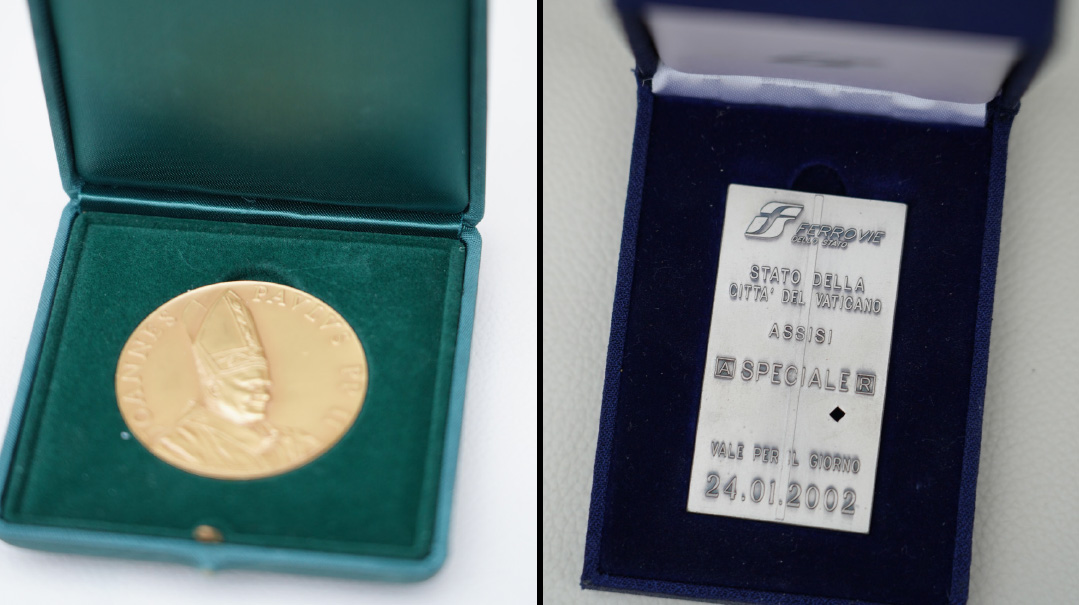
Mementos from the trip to Assisi together with the pope. The rabbis even had a tent for Minchah
Have Their Cake
Rabbi Plancey’s natural warmth and wit make it easy to see why the Chief Rabbi’s office and United Synagogue organization appointed him as a spokesperson and liaison. His manner is open and friendly, and he’s an expert at the art of the schmooze, finding common ground with everyone, from senior royals to the young police officers in the force where he served as chaplain for 35 years.
His encounters are a who’s who of personalities in the UK’s political and ruling classes, and he says he’s enjoyed every minute of those duties. “I’ve met every British Prime Minister since Harold Wilson, who served from 1974 to 1976,” Rabbi Plancey recounts.
Political figures have come and gone over the decades, but Rabbi Plancey has been a constant through it all. He was privileged to meet the late Queen Elizabeth, whose intrinsic grace and dignity never failed her. He once asked her majesty’s permission to make the blessing on seeing royalty. Once he did, she responded politely, “Thank you so much.”
Decades before King Charles ascended the throne, the crown prince built an association with the Jewish community, and Rabbi Plancey is one of those who got to know the longtime heir through his attendance at Jewish communal events. “A long time ago, when his boys William and Harry were really young, I met Charles at a function and the boys were mucking about. He actually had to tell the princes to behave,’ ” he remembers.
As we’re sitting around the dining room table that’s hosted hundreds of the rabbi’s congregants and guests, and even a Friday night minyan after his retirement, Rabbi Plancey brings out a small, flat-square object, frozen solid.
“Do you know what this is?” he asks. We try to guess, and then he shows us the royal insignia on the tin which encased it. As a representative of the Chief Rabbi and the Jewish community, he attended the wedding and was one of the lucky 4,000 chosen to receive a piece of William and Kate’s £56,000, eight-tier wedding cake. It was sent to him as a gift in a commemorative tin with the couple’s insignia. Slices of this wedding cake retail in auctions for a nice sum, but Rabbi Plancey is not selling. Or, to be accurate, he only sells it with the rest of his chometz, and always gets it back.
As in every rabbi’s house, there’s a room lined with seforim and Judaica, but Rabbi Plancey’s shelves also hold their fair share of interesting souvenirs and memorabilia. He looks around his cabinets for a small leaf of sterling silver, a gift from Pope John Paul II. In 2002, the rabbi was part of a delegation of 11 rabbis invited to the Vatican by the pope. Their visit included a trip on a presidential train to the Catholic pilgrimage town of Assisi. The pope traveled in the front cabin, with the rabbinic delegates behind him.
“The Muslim delegates were wondering why they were further down the train, until the pope commented that Judaism is ‘the mother religion,’ ” Rabbi Plancey relates. “Since he knew that the rabbis wouldn’t enter the chapel, he arranged for a marquee [tent] next to it. We had a minyan for Minchah there in the marquee, and after Shemoneh Esreh, there was some schmoozing. The videographer who was filming the event wanted to know if that was part of the service. When we parted, the pope kissed me and said ‘Shalom al Yisrael.’ He was incredibly respectful.”
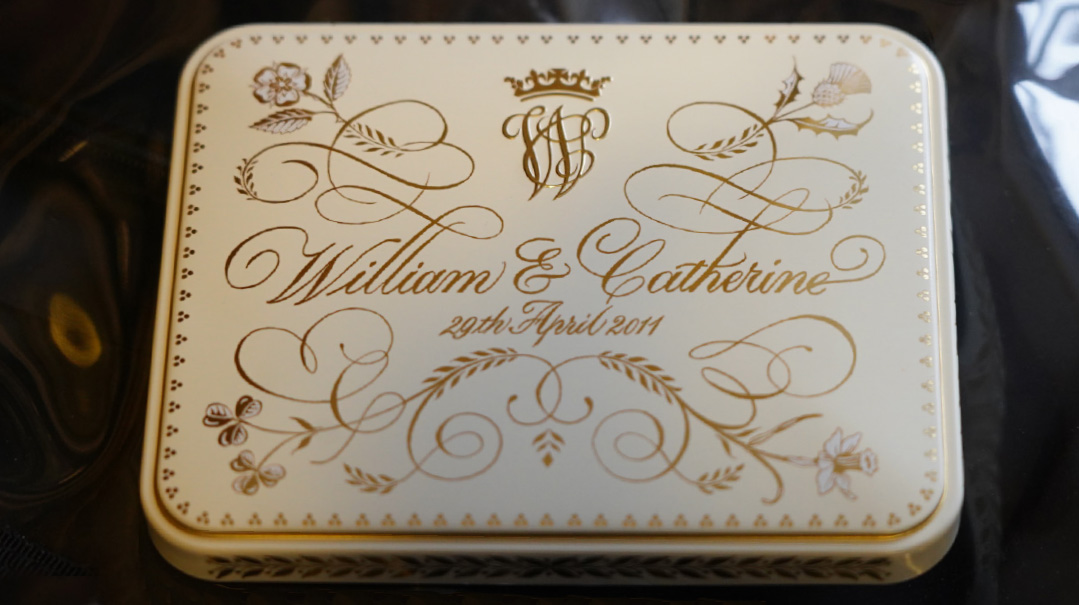
A
fter seven years in Hampstead, the call came from another community, which would become synonymous with Rabbi Plancey’s name and imprint. Today, Borehamwood is one of the UK’s largest communities, but back in the early 1970s, there were less than 100 Jewish families in the area. They wanted Rabbi Plancey to help set up and run a Sunday Jewish studies “cheder” program, as he’d been very successful with the cheder in Luton.
When the post in Borehamwood became vacant, 13 rabbis applied for the position. “Everyone knew there was potential here, that it was an up-and-coming destination for Jewish families,” Rabbi Plancey says. “Forty years ago, when we came, the central board of the United Synagogue offered to fund either grounds for a shul, or a house for a rabbi. I told them I’d buy my own house, and they should fund the shul.” By 2007, when the Planceys retired, there were 1,200 member families, plus shuls in neighboring Radlett and Shenley, which split off from Borehamwood.
With Rabbi Plancey at the helm, the community, which identifies at Modern Orthodox, had a strong focus on learning and growth, and was constantly expanding, building first a Jewish nursery, then a day school and secondary school, and a mikveh. The Planceys made sure to bring prominent and inspiring guests to Borehamwood for Shabbos, from Chief Rabbi Yisrael Meir Lau and Rabbi Shlomo Goren to Rav Yitzchak Dovid Grossman, Rabbi Dr. Akiva Tatz, and Rebbetzin Tzipporah Heller Gottlieb, as well as a frum astronaut and Jewish film producers.
Traditionally, the Chief Rabbi is based in St. John’s Wood, near Central London, but both Rabbi Jacobowitz and Rabbi Sacks loved the community Rabbi Plancey was building up in Borehamwood.
“Chief Rabbi Jacobowitz and Lady J. spent many Shabbosos here, and one Yom Kippur, too,” Rabbi Plancey says. “They also joined us when I had invited a group of injured Israeli war veterans to the community over Shabbos. Some of the soldiers were secular Jews, but they had all been wounded in fighting for Israel, and so were invited to England by a Jewish charity. Some had never heard Kiddush before, but Lord Jacobowitz was unfazed. He made Kiddush and Hamotzi, then took off his jacket and tie and sat down near the end of the table to speak and teach and sing. There were no airs or graces — he just sat down as a friend.”
Chief Rabbi Sacks once spent a Shabbos away in Bournemouth with the Borehamwood community group, and likewise made himself approachable and friendly. “He sat down to sing with us in a kumzitz, and asked everyone in the circle to tell a story from their own life that made them feel Jewish.”
Under Rabbi Plancey’s tenure, Borehamwood opened its first mikveh. But he didn’t want it opened without people knowing how to use it. His initiative to bring Rabbi Yirmiyahu and Rebbetzin Tehillah Abramov, founders of “Jewish Marriage Education,” for a week of intensive courses meant that over 100 couples learned about taharas hamishpachah from this dynamic couple.
Rabbi Plancey shares the secret of his success in his rabbinic position. “Make the people your family. Invite them in. I could not have done any of it without my wife, who hosted so graciously and tirelessly. We opened the door to our home, because we decided to start out with chesed. The table was full on Shabbos and Yom Tov, for the Seder, for Succos, and on Shavuos night when everyone was invited round to learn and nosh from the table laden with cheesecakes and blintzes. After we retired from Borehamwood, we served in Northwood for two years, and there we had every single couple over for dinner at some point. Every person gets treated as an equal.”
A rabbi has to have broad enough shoulders to be able to stick to the rules. Rabbi Plancey was in regular contact with London’s foremost dayanim when it came to the thornier communal and personal issues he faced. “The balabatim knew I was very Orthodox, a Gateshead yeshivah product, but they didn’t resent it,” he says. “Besides, everybody liked my wife.”
He also had to be there for individuals in crisis. “There are several women in the community whose ex-husbands want to shoot me because I helped the beis din to hurry the gittin through, and after their gets were issued, the men realized they had lost the bargaining power over their ex-wives.”
One family was planning a big bar mitzvah in the Borehamwood synagogue, but Rabbi Plancey was aware that the estranged husband was refusing to give his wife a get. He sent a message that he would not be able to call up the father for an aliyah, nor mention him in the sermon. The man called up, outraged. “Did you say that you won’t call me up at my son’s bar mitzvah?”
“Yes, I did, I’m sorry.”
“And if I give the get this week?”
“If you can get the get through the beis din this week, you can have all the honors in shul at the bar mitzvah.”
The threat of public disgrace swayed this man, and on Friday morning, Rabbi Plancey got an emotional phone call from the wife: She had her get. The ex-husband, meanwhile, was called up for Shlishi and congratulated in the sermon.
Another World
Fourteen years ago, just after the Planceys retired, Rabbi Plancey received a call from the local branch of the Conservative party. A councillor had just died, and they wanted to put his name forward as a replacement.
“As a rabbi, I never got involved in politics,” he reflects, “but I’d retired, so it was a different story.” One term on the council led to another, and after four years, Rabbi Plancey was voted in as the local mayor.
He handled the role with dignity and became a popular local figure, encouraging respect between the different faith communities and making a kiddush Hashem time and again, wearing his mayoral chains with a yarmulke and distinctly Jewish appearance. He’d been a chaplain to the Hertsmere Police Force and Luton Airport for decades, supporting young officers after violent incidents and deaths, and with his distinguished, serious and scholarly demeanor notwithstanding, he still has plenty of the everyman charm. Still, by the time he was up for re-election in 2020, tides had turned. Respect for religion, pretty much universal just decades ago, was being eroded fast all over the UK. Liberal lobbyists were not going to let an Orthodox rabbi represent the borough, and so they released a 2014 video of Rabbi Plancey giving an interview in which he answered a question explaining the halachic view of deviant lifestyles, labelling him as “homophobic.”
The attacks blindsided him. Used to being respected as a man of religion, a man of G-d, he was suddenly vilified as a bigot. “My wife said I should be proud. The local police chief called to say, ‘All you were doing was quoting your religion — they should have a bit more respect.’ It was a shock, because throughout my rabbinic career, I never encountered anti-Semitism, only respect. But politics is another world. I have to live with this and rise above it.”
Yet despite the increased levels of tension and more militant attitudes, Rabbi Plancey believes in the power of geniality that is such a part of his own nature. He believes that we can all make a better effort to get along.
“As mayor, I was invited to a break-the-fast party made by the local Muslims during Ramadan,” he relates. “They told me they’d bought kosher chicken for me, but of course, they had cooked it in their own pots. Seated there, I spied a sealed package of kosher pita. I sat down with them and made a brachah on the pita, and they were all happy with that.”
In his private life, he’s also reaping the benefits of decades of communal investment. The late Dayan Ehrentreu saw Borehamwood as fertile ground for a community kollel, which was established in 2019. That brought more yeshivish families to the area. Two other shuls have also sprung up recently, and there’s even a Hersmere Hatzolah, all building on the infrastructure the Planceys laid down. One major plus for the kollel families is that Edgware, which has developed over the past 20 years into a bustling frum kehillah, is just a ten-minute drive away.
Rabbi Plancey, who raised his own family here when it was off the yeshivish map, is enjoying the new dynamic. Now that he’s retired from his own shul, he can make the most of it, too. “I daven in the kollel now,” he says. “That’s the place for people who want to learn.” Because, as the Ponevezher Rav’s keen eye grasped long ago, the boy from working-class Glasgow really, really did want to learn.
(Originally featured in Mishpacha, Issue 960)
Oops! We could not locate your form.







